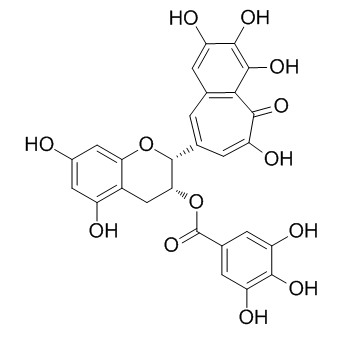Epitheaflagallin 3-O-gallate
Epitheaflagallin 3-O-gallate is a promising functional food material with potential antiobesity and antiperiodontal disease activities, it suppresses tumor growth through the suppression of angiogenesis. Epitheaflagallin 3-O-gallate also shows antioxidative activity, pancreatic lipase inhibition, Streptococcus sorbinus glycosyltransferase inhibition, and an inhibiting effect on the activity of matrix metalloprotease-1 and -3.
Inquire / Order:
manager@chemfaces.com
Technical Inquiries:
service@chemfaces.com
Tel:
+86-27-84237783
Fax:
+86-27-84254680
Address:
1 Building, No. 83, CheCheng Rd., Wuhan Economic and Technological Development Zone, Wuhan, Hubei 430056, PRC
Providing storage is as stated on the product vial and the vial is kept tightly sealed, the product can be stored for up to
24 months(2-8C).
Wherever possible, you should prepare and use solutions on the same day. However, if you need to make up stock solutions in advance, we recommend that you store the solution as aliquots in tightly sealed vials at -20C. Generally, these will be useable for up to two weeks. Before use, and prior to opening the vial we recommend that you allow your product to equilibrate to room temperature for at least 1 hour.
Need more advice on solubility, usage and handling? Please email to: service@chemfaces.com
The packaging of the product may have turned upside down during transportation, resulting in the natural compounds adhering to the neck or cap of the vial. take the vial out of its packaging and gently shake to let the compounds fall to the bottom of the vial. for liquid products, centrifuge at 200-500 RPM to gather the liquid at the bottom of the vial. try to avoid loss or contamination during handling.
Biomed Pharmacother.2023, 162:114617.
J Ethnopharmacol.2024, 320:117426.
Int J Mol Sci.2019, 20(11):E2734
bioRxiv - Biochemistry2023, 541790.
Int J Mol Sci.2021, 22(8):4211.
Int J Mol Sci.2024, 25(17):9673.
Int J Mol Sci.2023, 24(23):17118.
Evid Based Complement Alternat Med.2019, 2019:2135351
Industrial Crops and Products2023, 199:116746.
Sage Journals2024, v20:4,1350-1358
Related and Featured Products
J Agric Food Chem. 2017 Dec 6;65(48):10473-10481.
Functional Characterization of Epitheaflagallin 3-O-Gallate Generated in Laccase-Treated Green Tea Extracts in the Presence of Gallic Acid.[Pubmed:
29131612]
Epitheaflagallin (ETFG) and Epitheaflagallin 3-O-gallate (ETFGg) are minor polyphenols in black tea extract that are enzymatically synthesized from epigallocatechin (EGC) and epigallocatechin gallate (EGCg), respectively, in green tea extract via laccase oxidation in the presence of gallic acid.
METHODS AND RESULTS:
The constituents of laccase-treated green tea extract in the presence of gallic acid are thus quite different from those of nonlaccase-treated green tea extract: EGC and EGCg are present in lower concentrations, and ETFG and ETFGg are present in higher concentrations. Additionally, laccase-treated green tea extract contains further polymerized catechin derivatives, comparable with naturally fermented teas such as oolong tea and black tea. We found that ETFGg and laccase-treated green tea extracts exhibit versatile physiological functions in vivo and in vitro, including antioxidative activity, pancreatic lipase inhibition, Streptococcus sorbinus glycosyltransferase inhibition, and an inhibiting effect on the activity of matrix metalloprotease-1 and -3 and their synthesis by human gingival fibroblasts.
CONCLUSIONS:
We confirmed that these inhibitory effects of ETFGg in vitro match well with the results obtained by docking simulations of the compounds with their target enzymes or noncatalytic protein. Thus, ETFGg and laccase-treated green tea extracts containing ETFGg are promising functional food materials with potential antiobesity and antiperiodontal disease activities.
Enzyme Microb Technol. 2016 Jan;82:125-132.
Characterization and cloning of laccase gene from Hericium coralloides NBRC 7716 suitable for production of epitheaflagallin 3-O-gallate.[Pubmed:
26672458 ]
Epitheaflagallin 3-O-gallate (ETFGg) is a minor polyphenol found in black tea extract, which has good physiological functions. It is synthesized from epigallocatechin gallate (EGCg) with gallic acid via laccase oxidation.
METHODS AND RESULTS:
Various basidiomycetes and fungi were screened to find a suitable laccase for the production of ETFGg. A basidiomycete, Hericium coralloides NBRC 7716, produced an appropriate extracellular laccase.
The purified laccase produced twice the level of ETFGg compared with commercially available laccase from Trametes sp. The enzyme, termed Lcc2, is a monomeric protein with an apparent molecular mass of 67.2 kDa. The N-terminal amino acid sequence of Lcc2 is quite different from laccase isolated from the fruiting bodies of Hericium. Lcc2 showed similar substrate specificity to known laccases and could oxidize various phenolic substrates, including pyrogallol, gallic acid, and 2,6-dimethoxyphenol. The full-length lcc2 gene was obtained by PCR using degenerate primers, which were designed based on the N-terminal amino acid sequence of Lcc2 and conserved copper-binding sites of laccases, and 5'-, and 3'-RACE PCR with mRNA. The Lcc2 gene showed homology with Lentinula edodes laccase (sharing 77% amino acid identity with Lcc6).
CONCLUSIONS:
We successfully produced extracellular Lcc2 using a heterologous expression system with Saccharomyces cerevisiae. Moreover, it was confirmed that the recombinant laccase generates similar levels of ETFGg as the native enzyme.



